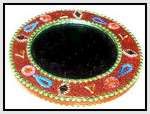|
 First archaeologically proved traces of Indian handicrafts belong to the Indus Valley civilization way back in 3000 B.C. During this time Indian craftsmen were doing excellent job in pottery making, bead making, terracotta, jewelry and weaving. The most significant aspect is the technical advancement in the handicrafts field at this time. The archaeologists have excavated many sites like Harappa, Mohenjodaro, Lothal, Chanhudaro, Kotdigy, Dholaveera etc. and they have found numerous artifacts that manifest the skill of the craftsmen at that time. First archaeologically proved traces of Indian handicrafts belong to the Indus Valley civilization way back in 3000 B.C. During this time Indian craftsmen were doing excellent job in pottery making, bead making, terracotta, jewelry and weaving. The most significant aspect is the technical advancement in the handicrafts field at this time. The archaeologists have excavated many sites like Harappa, Mohenjodaro, Lothal, Chanhudaro, Kotdigy, Dholaveera etc. and they have found numerous artifacts that manifest the skill of the craftsmen at that time.
In Vedic age (1500 B.C. to 700 B.C.) too a lot of advancement in handicrafts had taken place. There is reference of pottery making, weaving wood crafting etc in the Vedas. Rig Veda especially mentions about pottery made from clay, wood and metal. Weaving and weavers also find the reference in these holy texts. In the later Vedic period the principal development was the discovery of iron. This led to the manufacture of iron weapons on mass scale. Craftsmen got a huge exposure and the crafts traditions started to be entrenched in the social structure.
During Maurya period Indian handicrafts reached to perfection in certain art forms especially in stone crafts. After the great transformation of Ashoka from a hardcore imperialist to Buddhist reformist, numerous activities indulging the craftsmen began. It is said that not less than 84000 stupas were build during the reign of Ashoka. Most prominent stupas whose remains are still available are located at Sanchi, Bharhut, Vaishali, Amaravati and Mathura. Similarly the iron pillars of Delhi and Vaishali are the marvelous examples of metallurgy.
In the period followed by the Mauryan, an assimilation of regional influence took place in Indian arts and crafts. Since this period in Indian history was that of political turmoil, not a single dynasty could rule over India for a long time. The attacks of Indo-Greeks, Indo-Bactrians, Shakas and Kushanas made Indian scene topsy-turvy. Handicrafts of this age have direct influences of these invasions from central Asia and other regions. Buddhist sculptures belonging to this age found at Taxila, Begram, Swat Valley, Bamiyan etc. depict these influences clearly. Buddha with curly hair and wrapped in draperies was the result of Greek influence. The main crafts which got maximum influence of the Central Asian invasions were jewelry, sculpture, textile making, leather products and the metal works.
Gupta age has been called classical age of Indian history by historians. The art and crafts domain was also greatly affected by the political stability, efficient ruling, capable administration and the consistent patronage of art and crafts. Fascinating murals of Ajanta and the significant development in the technique and art of sculpture, jewelry making, wood carving stone carving and weaving were the highpoints of this age. Development in science, astrology, astronomy, mathematics, literature and physiology were the other greatest achievements of this time. Stone sculpture and metal sculpture were made maintaining the high standards. The rock cut temples of Ellora are the astonishing examples of stone craft. This structure raises the standard of Indian Crafts to the towering heights.
During Medieval period the onus of development in arts and crafts had been shifted to the southern peninsula of Indian subcontinent. The Chola Empire and Vijaynagara empire wholeheartedly supported the trade and commerce based on the art and crafts of the local artisans. The temples with numerous intricate details were carved. Gems and jewelry was given immense importance. Bronze sculpture and silk weaving craft reached at its zenith. In the Northern region of India, under Delhi Sultanate, the art of pottery making, weaving, wood carving, metal works and jewelry was also flourishing. Under the patronage of Mughal Empire, the art and science of architecture reached to the starry heights. Painting saw its zenith under the emperors Akbar, Jahangir and Shahjahan. School of Mughal paintings influenced other regional painting schools too like Pahari School of Painting, Rajput School of Painting, Kota School of Painting, Boondi School of Painting etc. The art of weaving also flourished during these times. Metallurgy covered several milestones during medieval period and several battles were fought using highly advanced technology in the guns and canons by the standard of that time.
source: here
|


 Dyscario Feed
Dyscario Feed